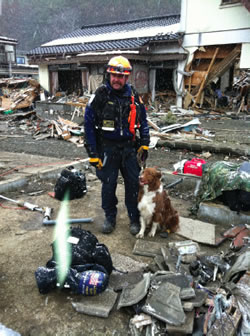The Patch
A team of L.A. County firefighters and trained dogs from the California-based National Disaster Search Dog Foundation spent a week searching for survivors in northeastern Japan.
Former South Pasadena Patch Editor Sonia Narang reports on the aftermath of the Japan earthquake from Osaka, Japan.
OSAKA–Freezing temperatures, snowfall and lack of electricity did not deter a team of 74 Los Angeles County Fire Department firefighters from carrying out an ongoing and very difficult search and rescue mission last week in and around Ofunato City, 330 miles north of Tokyo.
The large-scale destruction caused by the magnitude 9.0 earthquake and resulting tsunami on March 11 made the rescue work a complicated effort, said L.A. County Fire Battalion Chief Dave Stone, via telephone from Ofunato City.
“The debris piles are 30 to 40 feet high. There are vehicles on top of houses. There are lots of configurations for where people could be trapped,” Chief Stone said. “Rescue people are climbing on top of cranes, and debris piles are not stable,” he added. “What nature can do is almost mind-boggling.”
The search and rescue task force from the Los Angeles County Fire Department returned to L.A. this past weekend, on Saturday, from earthquake-and-tsunami-ravaged Japan, City News Service reported. The 74-members of the California Task Force 2 heavy rescue team returned after six days in Japan.
Large tsunami waves caused by the earthquake completely wiped out towns and villages along the northeastern coast of the country. As of March 19, the death toll climbed to more than 7,000 people, and more than 11,000 people were still missing.
The United States Agency for International Development (USAID), a government agency that provides humanitarian assistance overseas, dispatched the L.A. County firefighters to Japan two days after they returned from an earthquake rescue mission in New Zealand. The California team was joined by firefighters from Fairfax, VA, and the United Kingdom.
In addition, six search and rescue dogs trained by the National Disaster Search Dog Foundation helped firefighters look for survivors in the debris.
The firefighters and search dogs arrived in Misawa U.S. Air Force Base, northern Japan, on March 12. From there, they were transported in military vehicles to Ofunato City, a hard-hit coastal town six hours south of the air base.
The California and Virginia teams carried 45 tons of equipment with them, and they can function self-sufficiently for up to 10 days.
Firefighters and search dogs looked for victims in the debris, but were unable to find survivors, according to L.A. County Fire Captain Marc Savage, who is based in Los Angeles, but checks in frequently with his team in Japan.
“Things are looking difficult,” he said. “These places have just been leveled.”
Still, the firefighters and dogs have maintained their morale, Chief Stone said. They will continue to search, he said, and they are not sure yet when they will return to the U.S.
“We searched long and hard pushing the dogs searching for live people,” L.A. County firefighter Bill Monahan said earlier this week. They worked in the rain and snow, and stayed in a school gymnasium with the other international firefighter teams. They brought their own food, water, shelter, heaters, shower facilities and turned the gym into a ‘mini-city,'” Chief Stone said.
The dogs are well-trained to bark if they find a victim who needs rescuing. Each dog is paired with a firefighter handler from the Los Angeles area.
The Search Dog Foundation rescued these dogs from shelters and trained them to become skilled search dogs.
“The dogs and their handlers are inseparable,” said Janet Reineck, spokesperson for the National Disaster Search Dog Foundation.
The dogs live with the firefighters, Reineck said, and noted that the dogs become a part of the firefighters’ families.
L.A. County Firefighter/Paramedic Jasmine Segura of Redondo Beach has worked with her black lab Cadillac since 2007.
“He’s very calm until he sees a toy,” Segura said. “Then he becomes very driven and would go through a brick wall to reach that toy.”
Segura and Cadillac spent 16 days in Haiti after the earthquake there last year, and they searched for survivors in massive amounts of wreckage. The team, along with the six other canine disaster search teams, helped find 12 victims under all the concrete and debris in Haiti.
This time around, the firefighters and dogs have not been able to locate any survivors, Chief Stone said. Part of the reason, according to Stone, is that Japan’s robust earthquake and tsunami warning system notified many residents 13 to 15 minutes before the destructive waves submerged homes, cars, and streets.
“The early warning sirens went off, and people were able to move to higher ground,” he said.
Many others perished when the water engulfed complete areas and knocked over homes. Some of those bodies have been recovered.
Chief Stone said the U.S. firefighters received logistical support from the Osaka Fire Department and local firefighters during their search.
“There’s a good partnership between local and international teams,” he said. “We’ve been working with so many people and responders,” he added and noted the L.A. firefighters similarly coordinate efforts with other departments when fighting brush fires in California.
“Task Force members remove a layer of debris after it is searched and then we work the next layer,” firefighter Gary Durian said about the procedure used to locate survivors.
“The hand that’s been dealt to the rescuers is a challenging one,” Captain Savage said. “They’re exposed to the elements, and it’s a dire situation. We’re monitoring the radiological materials very closely.”
Chief Stone said the firefighters have not been exposed to the radiation released from the Fukushima nuclear power plant reactors, due to their location 150 miles north. The firefighters have used dosimeters to measure radiation levels, which have been normal in their area, according to Chief Stone.
He added that temperatures have dropped to freezing and the snow has posed a new challenge.
“This is the first time we’ve worked in cold weather,” he said.
On Thursday morning, the school where the firefighters are staying invited the team leaders to attend the sixth grade graduation. Even in the face of such adversity and hardship, the students made it back to school for the first time since the disaster struck.
“There is a high amount of resolve among the people here,” Chief Stone said. “They are very respectful and are trying to sort things out.”
By Sonia Narang


